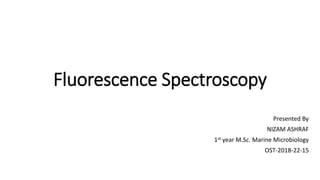
Fluorescence Spectroscopy
- 1. Fluorescence Spectroscopy Presented By NIZAM ASHRAF 1st year M.Sc. Marine Microbiology OST-2018-22-15
- 2. • Fluorescence is the emission of light by a substance that has absorbed light or other electromagnetic radiation. • Fluorescence spectroscopy (fluorimetry or spectrofluorometry) is a type of electromagnetic spectroscopy which analyzes fluorescence from a sample. • It involves the use of a beam of light, usually ultraviolet light, that excites the electrons in molecules of certain compounds and causes them to emit light of a lower energy; typically, visible light. • A complementary technique is absorption spectroscopy. • Devices that measure fluorescence are called fluorometers or fluorimeters.
- 4. Theory • Fluorescence spectroscopy is a fast, simple and inexpensive method to determine the concentration of an analyte in solution based on its fluorescent properties. • It can be used for relatively simple analyses, where the type of compound to be analyzed (‘analyte’) is known, to do a quantitative analysis to determine the concentration of the analytes. • Fluorescence is used mainly for measuring compounds in solution.
- 5. • In fluorescence spectroscopy, a beam with a wavelength varying between 180 and ∼800 nm passes through a solution in a cuvette. • We then measure from an angle the light emitted by the sample. • In fluorescence spectrometry both an excitation spectrum (the light that is absorbed by the sample) and/or an emission spectrum (the light emitted by the sample) can be measured. • The concentration of the analyte is directly proportional with the intensity of the emission. • There are several parameters influencing the intensity and shape of the spectra. When recording an emission spectrum the intensity is dependent on the: • Excitation wavelength • Concentration of the analyte solvent • Path length of the cuvette • Self-absorption of the sample
- 7. Instrumentation Filter Fluorometers Spectro Fluorometers Use filters to isolate the incident light and fluorescent light. Use diffraction grating monochromators to isolate the incident light and fluorescent light.
- 9. • The light from an excitation source passes through a filter or monochromator (1), and passes through the sample. Here some of it is absorbed, making some of the molecules in the sample fluoresce. • A part of the fluorescent light is then focused on a filter or monochromator (2), which often is placed at a 90° angle to the excitation light. • The light is then detected by a detection device. • Various light sources may be used as excitation sources; (lasers, photodiodes; xenon arcs and mercury vapour lamps).
- 10. • A laser only emits light of high irradiance at a very narrow wavelength interval, typically under 0.01 nm, which makes an excitation monochromator or filter unnecessary. • The disadvantage is that wavelength of a laser cannot be changed much. • A mercury vapour lamp is a line lamp, meaning it emits light near peak wavelengths contrary to the Xe arc, which have a continuous emission spectrum with intensity in the range from 300-800 nm.
- 11. • Filters and/or monochromators may be used in fluorimeters. A monochromator transmits light of an adjustable wavelength with an adjustable tolerance. • The monochromator can then select which wavelength to transmit. • For allowing anisotropy measurements, the addition of two polarization filters are necessary: • One after the excitation monochromator or filter, and • One before the emission monochromator or filter. • No monochromator is perfect and it will transmit some stray light, ie; light with other wavelengths than the targeted. • An ideal monochromator would only transmit light in the specified range and have a high wavelength-independent transmission.
- 12. • The detector can either be single-channeled or multi-channeled. • The single channeled detector can only detect the intensity of one wavelength at a time, while the multi-channeled one detects tin intensity of all wavelengths simultaneously, making the emission monochromator or filter unnecessary. • When measuring fluorescence spectra, the wavelength of the excitation light is kept constant, preferably at a wavelength of high absorption, and the emission monochromator scans the spectrum. • For measuring excitation spectra, the wavelength passing through the emission filter or monochromator is kept constant and the excitation monochromator is scanned.
- 13. • An excitation (also called an absorption spectrum) and an emission spectrum of a fluorescent compound can be made. • The absorption spectrum tells us which incoming wavelengths are absorbed by the solution, with the emission or fluorescence spectrum we can see which wavelengths are emitted after absorbing the incoming light.
- 14. Applications • It is used in biochemical, medical, and chemical research fields, for analyzing organic compounds. • Used in differentiating malign skin tumors from benign. • In analytical chemistry, fluorescence detectors are used with HPLC.
- 15. Thank You
